Use GRiSP with off-the-shelf hardware
Digilent PMod-Compatible
The connectors on Grisp-Base are compatible with Digilent PMod accessories, providing access to dozens of affordable, ready-to-run expansion modules with sensors (accelerometer, gyro, compass, several temperature, general A/D, and even a GPS module) and actuators (motor drivers, RC-servos, audio out).
This gives us the opportunity to provide high-level Erlang drivers for most of those PMods. Since there will be port-drivers or native-implemented functions (NIFs) for the basic protocols, most of these drivers can be written in Erlang. Dropping down to C is very rarely necessary.
Compatible modules provide an easy entry point to small hardware development projects. The modular hardware you create would be reusable with future GRiSP versions, and other PMod-compatible boards.


